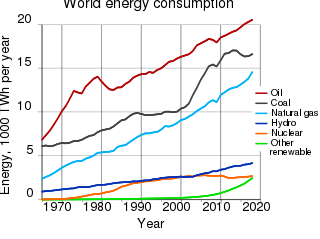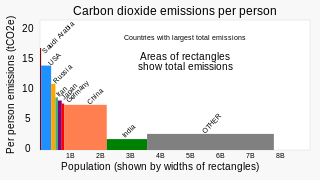Policy decisions
Since 1979, many pieces of legislation have been passed in China regarding environmental protection, including:
Laws regarding pollution: Solid Waste Pollution Prevention and Control Law, Water Pollution Prevention and Control Law, Air Pollution Prevention Law, Water Pollution Control Regulation, The Energy Conservation Law. [23]
Laws regarding recycling and clean production: Clean Production Promotion Law, Renewable Energy Law, Circular Economy Promotion Law. [23]
China has also passed a number of laws for developing renewable energy and optimizing China’s energy structure, including: Energy Conservation Law, Eleventh Five-Year Plan – Outline for Economic and Social Development, Plan of Energy Efficiency and Emissions Reduction, Eleventh Five-Year Plan for Environmental Protection, National Climate Change Program, Climate Change Policies and Actions, and the New Energy Development Plan. [23]
These policies aim to develop innovations and optimizations for various power generation technologies, including thermoelectric, hydroelectric, solar, wind, biofuel, and nuclear. In addition, the “policies promote the clean usage of coal, the use of coal-bed and coal-well gas”. [23]
In 2007, the state council also issued the Comprehensive Plan to Save Energy and Reduce Emissions, giving 45 policy measures to save energy and reduce emissions. The measures related to technological innovation of traditional industries are as follows:
“Accelerate the desulphurization of current facilities for thermal power units, enhancing desulphurized unit’s capacity to 213 million kW. Newly built or expanded coal power plants must build desulphurized facilities and reserve places for denitration. Further promote projects in coal washing and clean-burning coal technologies. Strengthen the paper making, brewing, chemical, textile and dyeing industry’s waste water and pollution management and technological innovation”. [23]
The Chinese government has also implemented measures to promote recycling pilot projects, achieve clean production, and reduce emissions with the Promotion of Clean Production Law, the Solid Waste Pollution Prevention Law, the Promotion of Recycling Law, Rules on Managing Daily Waste, Regulations on Recycling and Handling Electronic Products, as well issuing the Interim Provisions on Promoting Industrial Structure Adjustment, Opinions on Accelerating the Development of the Recycling Economy, Guiding Opinions on the Comprehensive Use of Resources during the Eleventh Five-Year Plan, the Notice of Energy Conservation and Emission Reductions, the Eleventh Five-Year Plan for National Environmental Protection, and Policies and Actions Addressing Climate Change, etc. [23] Additionally, Chapter six of the Eleventh Five-Year Plan for national economic and social development describes a plan for developing China’s recycling industry, based on energy saving to mobilize the whole society to recycle. [23]
Another policy focus for green-collar work in China lies in comprehensive resource utilization to achieve speedy development of resource utilization industries, which aims to improve the efficiency of resource use and increase usage for industrial waste. [23]
China has also made policies to develop the environmental protection industry with the Eleventh Five-Year plan. The plan proposed to develop large-scale high efficiency clean power generating facilities and equipment for environmental protection and the comprehensive use of resources. The Plan also proposed to develop equipment manufacturing for environmental protection based on the needs of key environmental protection projects; to actively develop a service industry prioritizing environmental impact assessment, environmental project service; environmental technology research and development; and environmental venture investment. [23]
The Chinese government has also set up a fund for environmental management and supported a number of key projects in ecological management and pollution management through national bonds. [23] These projects include controlling sandstorms in Beijing and Tianjin, setting up environmental protection facilities in west region, control pollution in three rivers and lakes, recycle waste water, industrialize of recycled waste and treated water, engage in environmental pollution management in Beijing, and subsidize programs that benefit forest ecology. [23]
Subsidies have also been introduced to facilitate the growth of green-collar work. These subsidies include electricity price subsidies for desulphurization processes, ecological construction projects (such as climate adaptation measures), clean production projects, environmental research, and production of eco-friendly projects. [23]
China has introduced numerous tax policies to encourage green-collar work. First, the government has introduced tax policies that waives and reduces value-added tax (VAT) for enterprises that comprehensively use resources, that recycle and on-sell waste materials, that buy in waste and recycled products, that create clean energy, that produce environmental protection products, and that process waste-water. [23] For example, since 2001, administrative agencies at all levels have waived VAT for waste-water fees collected by water plants. [23] There have also been reforms for taxes on oil products, which has the effect of encouraging development of low-consumption cars and new-energy cars. [23] Income taxes are also waived and reduced for enterprises that use waste material as raw materials in production and that are producing environmental protection facilities and products. [23] A tax credit for investment and accelerated depreciation policy has also been introduced for environmental protection facilities. [23] China also introduced a resource tax in 1988 that has since been expanded to include: a carbon tax; tax refund recissions for enterprises that export resource-based products such as refined mineral products and crude oil; reductions in the tax refund rate on copper, nickel, ferroalloy, coking coal and hard coke; and reduced tax refund rate for enterprises with high energy consumption and high pollution. [23]
Financial policies have also been enacted to promote the development of green-collar work in China. In 2007, former SEPA, in cooperation with the China People’s Bank, and CBRC issued Opinions Regarding the Implementation of Environmental Policies and Regulations requiring the People’s Bank and CBRC to work with environmental agencies to guide financial institutions at all levels to introduce different credit policies for enterprises that are forbidden, have been shut down or have restrictions. [23] In particular new loans could not be provided for projects which have not met environmental approvals. [23] Later that year in December 2007, the Ministry of Environmental Protection and CIRC jointly issued the Opinions Regarding Environmental Pollution Liability Insurance, formally launching the green insurance system. [23]
Additionally, China has put forth documents detailing their forestry plans, including: National Afforestation and Greening Plan (2016–2020), National Forest Management Plan (2016–2050), Action Plan for Climate Change in Forestry in the 13th Five-Year Plan, Action Plan for Forestry to Adapt to Climate Change (2016–2020). [24]
Working Conditions
Workers in Green-collar jobs in China generally enjoy better job security and benefits compared to other industries due to the difficulty in outsourcing this kind of work. [23] These benefits include housing and transportation subsidies, health checks, social security, as well as unemployment and workplace injury insurance. [23] However, in green energy production particularly, overtime and long shifts are very common, largely due to the fact that green energy industries are growing faster than qualified labor is able to be trained. [25] While these workers were typically compensated with overtime pay or supplementary leave, long working hours generally reduce a worker’s performance, makes them more susceptible to occupational hazards, and reduce the quality of family life. [25] However, green energy-production work in China is generally less hazardous than non-green energy production work, such as coal mining. [23] But there are still notable hazards associated with green-collar jobs, particularly in power generation systems, such as blade ejection, tower collapse, overheating, the use of high voltage electricity, the use of rotating machinery, working at significant heights, the handling of heavy equipment, etc. [25]
Many workers in green energy-production jobs in China report that they belonged to labor unions, and that representatives were able to participate in companies’ management. [23] The unions also help carry out support programs for employees, which have contributed to the stability and satisfaction of the green-energy workforce. However, it is unclear how representatives influence decisions in management, and whether or not workers’ voices can be truly reflected in the representatives, since representatives are not always produced through direct elections. [25] It is also worth noting that Chinese workers are not entitled to organize independent trade unions, and that all trade unions must be affiliated with the All-China Federation of Trade Unions (ACFTU), and the formation of competing unions is prohibited. [25] Whether state or privately owned, most trade union representatives are elected by management, rather than by workers, [25] meaning that workers’ voices often go unheard.
Forestry Industry in China
Forests are one of the most economical carbon absorbers, with huge employment opportunities in three main areas: first, forestation and reforestation, restoration of degraded forests, and developing a joint system of forestry and agriculture to improve the sustainable development of forests; second, timber production and processing; third, sectors related to forestry, such as forest-tourism, developing chemicals for forests, forest machinery, forestry food, herbal medicines, etc. [23] In 2007, China’s total forestation was 2,680,000 hectares, with 980,000 workers registered across all natural forest conservation projects in China. [23] At the same time, there were a total of 1,849,200 registered forestry workers across those who worked in the fields of agricultural forestry and fishery, the fields of public management and organization, in water environment and facility management, and scientific research services. [23] According to the China Forestry Statistical Yearbook 2008, China had over 1200 forest parks, directly or indirectly creating 3.5 million jobs. The UN Food and Agriculture Organization estimates that forest restoration can create 10 million green jobs, particularly in organic farming and biofuel production. [23]
Forestry efforts have received criticisms for being ineffective and even exacerbating desertification and other ecological problems. [26] Many afforestation efforts have relied on monoculture style planting of trees, without taking local ecology into account, in a style called 一刀切 (yi1dao1qie1), or “cutting everything with the same knife”. [26] Monoculture afforestation has a few problems ecologically: first, that monoculture trees act as natural pumps that deplete groundwater and intensifies desertification; second, that monoculture manufactures a homogenized landscape that has little regenerative capacity; and third, that monoculture forests are vulnerable to disease and makes for a poor wildlife habitat. [26]














